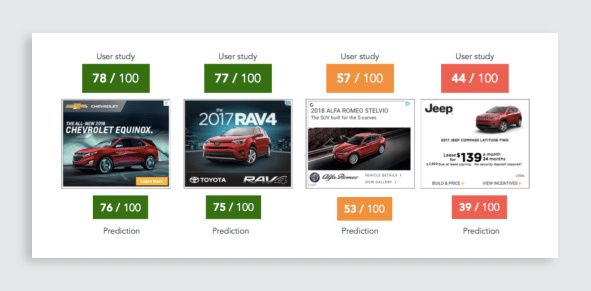
EyeQuant is training software to predict how irresistible banner ads will be to human eyes. Welcome to the future of AI-powered marketing.
The Berlin-based company EyeQuant uses eye-tracking tech for marketing and design, including utilizing machine learning to evaluate the usability of websites. Now, it’s training AI to predict what kinds of banner ads actually catch people’s eyes with 85% accuracy.
The company calls the still-unreleased product “Ad Visibility Score,” and says it will eventually help companies understand the true reach of their online ads. Right now, nobody has much of a clue about what’s going on with all those banners–and EyeQuant wants to change that. “The algorithm analyzes the visual characteristics of an ad from simple features like colors and contrasts, to more complex factors like object recognition,” EyeQuant’s VP of client services Kurtis Morrison told me over email. It uses this information to predict how eye-catching the design will be in a few seconds, giving you a 0 to 100 score. The higher the number, the more eye-catching your ad will be.
In a recent blog post, the company explains some of the takeaways from its development process. “For starters, it’s very easy to design a complete dud. Most marketers think of design as an intuitive skill–that a good design team just knows how to make an ad ‘pop,’” the company writes. “In fact, the EyeQuant algorithm shows that the ads running for some of the world’s top brands are highly inconsistent, and include examples of painfully ineffective creative.”
To train the AI, Morrison says that the company first recruited 500 people to record their perceptual reactions on a large set of banner ads. Based on their eye movements, the company could detect which ads caught viewers’ attention and which ad didn’t, rating each ad on a scale from 0 to 100. The company used that dataset to train a deep learning model built on top of an existing AI model, which had previously been trained with millions of images.
Right now, EyeQuant can’t cite specific reasons why the AI can be so accurate in its predictions. “We’d like to be able to isolate specific reasons for why one ad works better than another, or even to automatically generate eye-catching banners,” says A.I. Engineer Peli Teloni, but right now they can only speculate why. From what they’ve seen, the imagery, the color, and the total amount of text seem to all play a part. Big images, more color, high contrast, and less text seem to be key in getting a higher score. But Teloni also says that they’ve found that “some weird patterns tend to work extremely well”–and they have no clue why. EyeQuant is still investigating its model to try to understand it better.
Perhaps the real surprise is not the fact that AI can predict what humans find eye-catching–after all, we’re a pretty predictable species–but that they may have found a way to get us to look at banner ads at all.